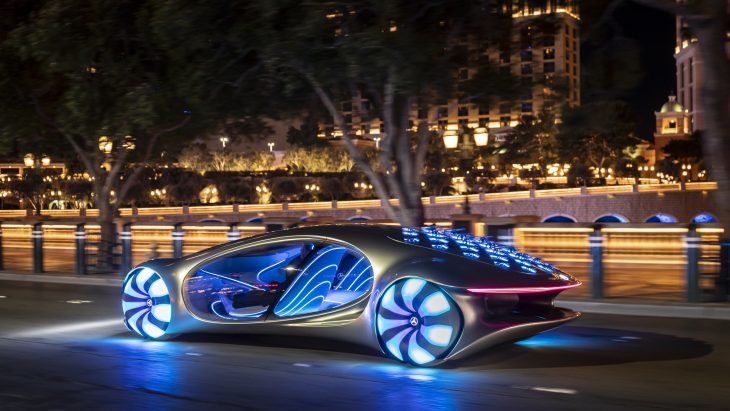
By John Bugailiskis
LAS VEGAS – When it comes to showing the most extreme tech of the future at CES, the award so far goes to Mercedes-Benz, which revealed a new concept electric car called Vision Advance Vision Transportation or AVTR.
The car manufacturer actually collaborated with Avatar director James Cameron on the design of the AVTR which has a “scaly reptile look” and wouldn’t look out of place on the fictional planet Pandora.
Cameron took to the stage alongside the car and Ola Källenius, head of Daimler and Mercedes for Källenius’ keynote. It only took a few moments for Cameron to get slammed on social media on whether the AVTR or his long-delayed film Avatar 2 would come out first. Unlike Sony however, which unveiled its own futuristic electric concept car at CES (the Vision-S, pictured at right) but has no plans to move to production, Mercedes is intent on creating cars like the AVTR that create a “bond between human and  machine.”
machine.”
The AVTR concept uses what the manufacturer claims is a revolutionary battery technology developed with graphene-based organic cell chemistry that is completely free of rare earths and metals. The materials of the battery are compostable and completely recyclable. The car said Källenius exemplifies Mercedes-Benz’s mission to develop “zero impact cars” and a future of mobility in which “man, nature and technology are no longer contradictions, but are in harmony with each other.” The car, which is fully autonomous and has no steering wheel or pedals, can apparently travel over 400 miles per charge.
At this point we assume it will still have an AM/FM radio.
The 33 multi-directionally movable surface elements on the back of the vehicle act as bionic flaps and resemble the scales of reptiles. These scales can communicate information to the driver and to the car’s surrounding environment via subtle “flowing” gestures. The front and rear axles of the car can even be driven in the same or opposite direction, enabling the car to move sideways by around 30 degrees “like a crab”, as well as forwards and backwards.
“We didn’t want to create a car, we wanted to create something like a living organism,” said Mercedes-Benz chief design officer Gorden Wagener at the keynote.
The vehicle is able to recognize the passenger’s heartbeat and breathing after placing their hand on the control unit. If the passenger lifts their hand, a menu selection is projected onto their palm, which they can use to select different driving functions.
Källenius also took the opportunity to dismiss the notion that eliminating cars altogether would be better for the planet. “We understand the boundaries of our planet. But we don’t want to add new boundaries to mobility. In other words: Fewer cars are not the solution. Better cars are.”
Bringing humans, machines and nature closer together will require action on many different playing fields added Källenius. “For us, step one is reducing our CO2 footprint: We’ve started that under the headline of ‘Ambition 2039.’ We’re aiming at carbon-neutral vehicle production, growing the share of electric vehicles sold, and, finally, having a carbon-neutral new passenger car fleet by 2039.”
He added the company wants to address this goal in a holistic way. This includes driving its suppliers and partners to comply with our objective of carbon neutrality.
The next step for Mercedes-Benz is focusing on resource preservation, for example saving water. “By 2030 our car production plants are set to reduce their total water consumption by a third per vehicle. That adds up to hundreds of millions of liters of drinking water. The ultimate goal, of course, is a fully closed water cycle. That means our plants reuse a lot of the process water throughout the factory,” said Källenius.
The other goal is to reduce energy consumption. By 2030, Källenius said its car production plants are set to reduce the energy they consume by more than 40% per vehicle.



